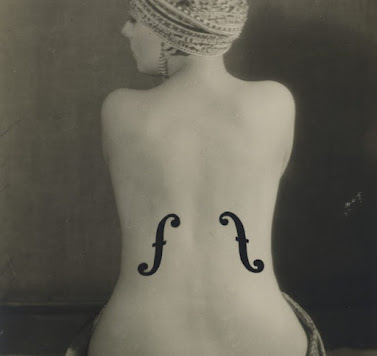Man Ray's Kono de Montparnasse Icon Now Becomes the Most Expensive Photo Ever Auctioned
Man Ray's Kono de Montparnasse Icon Now Becomes the Most Expensive Photo Ever Auctioned
Man Ray, Le Violon d'Ingres (1924) Man Ray, Le Violon d'Ingres (1924). Hosted by Christie's
Shortly after moving to Paris in 1921, American avant-garde artist Man Ray met and fell in love with actress and actress Alice Prin, who was nicknamed Kiki de Montparnasse. Kiki worked as a Surrealist and Dada museum for much of the next decade and, in 1924, took a photograph that became Ray's most famous work — and one of the most revered art pieces of the 20th century.
Now, nearly 100 years later, the iconic Le Violon d'Ingres — depicting Kiki's naked back covered with violin holes — has been sold at auction for a record-breaking $ 12.4 million. It is now the most expensive portrait ever sold at auction, breaking Christie's previous $ 5 million to $ 7 million auction.
"I would like to see you as the iconic Mona Lisa of the twentieth century," Darius Himes, Christie's international head of photography, said in a press release, as reported by Natasha Gural of Forbes. "... when it comes to photography, this is a truly sacred idea."
Le Violon d'Ingres first appeared in the magazine Dada- and Surrealism-focused Littérature in June 1924. The newly sold version is regarded as a copy of the original image, which has increased its value. It was New York collectors Rosalind Gersten Jacobs and Melvin Jacobs, who bought a painting from the artist directly in 1962.
The name of the painting is a nod to 19th-century French artist Jean-Auguste-Dominique Ingres, who sought recognition not only for his artistic skills but also for his ability to play the violin. He was so well-respected that the public did not take his music skills seriously, so he reduced his violin to a mere whim, according to Christie. To this day, violin d’Ingres is a French word meaning “fun.”
Ingres' grief apparently affected Ray, who wanted to be known not only as a photographer but also as a painter. Photography was “a technique he used to record his work and the works of his friends, but not something he wanted only to be associated with his artwork” and “was simply a way to express an idea,” according to the report. OkaChristie.
Ray also found inspiration in Ingres' own work, which included Baigneuse de Valpinçon and The Turkish Bath, two portraits focusing on a naked woman looking away from a spectator with a hat on her head.
Emmanuel Radnitsky born in Philadelphia in 1890, Ray was a curator Merry Foresta told Smithsonian Abby Callard in 2009, "a mysterious inventor, an alchemist."
Portrait of Man RayA 1934 photo of Man Ray by photographer Carl Van Vechten. Congress library
Kiki herself was a successful art museum, and modeled Amedeo Modigliani and other artists in the bohemian area of Paris. He was also an artist himself, and showed off his paintings in solo shows and group shows. But perhaps he was best known for his monuments, which documented the life of the Montparnasse louche and its wheelchair art community. The book, published in 1929, soon closed in the United States.
Meanwhile, “Parisians lined up to receive an automatic copy — and a kiss,” wrote Andrea Barnet in The New York Times in 1997, the year the monuments were published in the U.S.
To create the iconic image of Le Violon d'Ingres, Ray used what he called a “rayograph” method (commonly known as a photogram process), which involved burning f-hole in the light-sensitive paper, and then making a second exposure . of the image to combine the two together.
"I remember asking for Kiki's background, which is really a combination of image and rayograph — real as a rayograph," Ray wrote to Rosalind Gersten Jacobs, according to Christie.
Although Ray views photography as a hobby rather than a craft — his own violin d’Ingres — the historic sale of his portrait proves otherwise. As Himes tells Artnet's Taylor Dafoe, no other image "has proven to have the lasting power and passion of play that defines the Surrealists of the 1920s."
Art History History Art Artists Artists Auctions French Roaring Art Gallery Twentieth Surrealism
Recommended videos



No comments